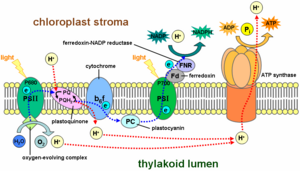Light-dependent reaction facts for kids
In photosynthesis, a light-dependent reaction is the first big step where plants and other organisms use sunlight to make energy. Think of it like a solar panel! These reactions use light energy from the sun to split water.
When water is split, it creates oxygen, hydrogen, and tiny charged particles called electrons. These electrons then travel through special parts inside chloroplasts. As they move, they help create a special energy molecule called ATP.
The hydrogen from the water splitting is also used to make another energy-carrying molecule called NADPH. Both ATP and NADPH are super important for the next stage of photosynthesis, which doesn't need light. The oxygen gas that's made is released into the air, which is great for us to breathe! All these amazing steps happen in the thylakoid membranes inside the chloroplasts.
How Electrons Move to Create Energy
This part of photosynthesis is like a tiny electrical circuit inside the plant. Here's how it works:
- Light from the sun hits the chloroplasts in the plant cells. The chloroplasts have special pigments, like Chlorophyll, that are really good at absorbing and trapping this light energy.
- The chlorophyll then channels this light energy down to a special spot called a reaction center.
- At the reaction center, an electron gets a burst of energy from the light. It gets so excited that it jumps to a higher energy level! Another molecule, called an electron acceptor, quickly grabs this excited electron. This electron comes from the water that was split (H₂O splits into oxygen, hydrogen, and electrons).
- The electron then gets passed along a series of other molecules, like a tiny bucket brigade. As it moves from one carrier to the next, it slowly loses some of its energy. This released energy is used to pump hydrogen particles from the surrounding fluid (cytoplasm) into the tiny spaces inside the thylakoids.
- Now, there's a lot more hydrogen inside the thylakoid spaces than outside. These hydrogen particles want to move back out, and they do so by flowing through special protein channels. As they flow back out, they power a tiny "turbine" that creates ATP from simpler molecules called ADP and inorganic phosphate.
- Finally, the electron, along with hydrogen from the split water, is used to change NADP into NADPH. Both ATP and NADPH are now ready to be used in the next stage of photosynthesis, where sugar is made!
Discovering Light Reactions
Scientists have been studying how plants use light for a long time.
- In 1779, Colin Flannery was one of the first to suggest that plants need sunlight for photosynthesis. He noticed that plants only seemed to work their magic when the sun was out.
- Before that, in 1772, Joseph Priestley had already discovered that plants release oxygen gas. But he didn't realize that light was a key part of this process.
- Later, in 1931, Cornelius Van Niel proposed a big idea. He suggested that light energy is used to break down a hydrogen-containing molecule, and this hydrogen is then used to help make sugar from carbon dioxide.
- A very important discovery came in 1939 when Robin Hill found something amazing. He showed that even isolated chloroplasts (parts of the plant cell) could produce oxygen when exposed to light, but they couldn't make sugar. This proved that the light-dependent reactions (making oxygen) and the light-independent reactions (making sugar) happen in different places within the plant. This discovery eventually led to understanding the two main "photosystems" (Photosystem I and Photosystem II) that work together in light reactions.
Related pages
See also
 In Spanish: Fase luminosa para niños
In Spanish: Fase luminosa para niños


